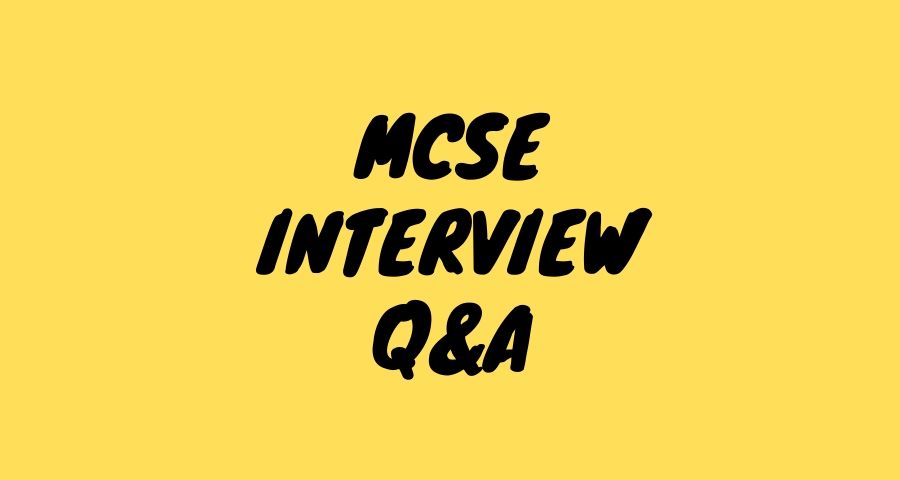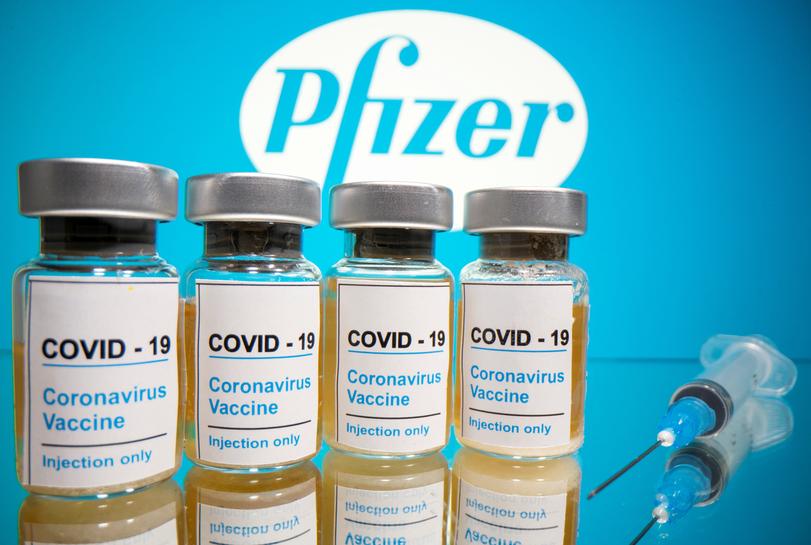A collection of top MCSE interview questions and answers for System Admins.
MCSE (Microsoft Certified Solutions Expert) is a senior level certification from Microsoft. MCSA (Microsoft Certified Solutions Associate) is an entry level certification. If a candidate has MCSE certification, then he is allowed to go to expert level.
MCSE Interview Questions
We have categorized our collection of MCSE job interview questions and answers based on following topics.
- Active Directory
- IPv6
- Networking
- Group Policy
- Hyper-V
- PowerShell
- DirectAccess
- Dynamic Access Control
- Certificates
Active Directory – Interview Questions
Active Directory Service is a directory service for handling windows domain networks developed by Microsoft. The job requires the candidate to have well knowledge on Windows server Operating Systems. Below are the frequently asked Active Directory interview questions and answers.
Beginner Level – Active Directory Interview Questions
Question 1. What is Active Directory?
Answer: Active Directory is a directory structure used on Microsoft Windows based servers and computers to store data and information about networks and domains.
Question 2. What is a Domain in Active Directory?
Answer: A domain defines both an administrative boundary and a security boundary for a collection of objects that are relevant to a specific group of users on a network.
A domain is an administrative boundary because administrative privileges do not extend to other domains.
It is a security boundary because each domain has a security policy that extends to all security accounts within the domain.
Active Directory stores information about objects in one or more domains. Domains can be organized into parent-child relationships to form a hierarchy. A parent domain is the domain directly superior in the hierarchy to one or more subordinate, or child, domains. A child domain also can be the parent of one or more child domains.
Question 3. Which is the Default Protocol used in Directory Services?
Answer: The default protocol used in directory services is LDAP ( Lightweight Directory Access Protocol).
Question 4. What is Mixed Mode?
Answer: It allows domain controllers running both Windows 2000 and earlier versions of Windows NT to co-exist in the domain. In mixed mode, the domain features from previous versions of Windows NT Server are still enabled, while some Windows 2000 features are disabled. Windows 2000 Server domains are installed in mixed mode by default. In mixed mode the domain may have Windows NT 4.0 backup domain controllers present. Nested groups are not supported in mixed mode.
Question 5. Explain The Term Forest In AD?
Answer: Forest is used to define an assembly of AD domains that share a single schema for the AD. All DC’s in the forest share this schema and is replicated in a hierarchical fashion among them.
Question 6. What is Native Mode?
Answer: When all the domain controllers in a given domain are running Windows 2000 Server. This mode allows organizations to take advantage of new Active Directory features such as Universal groups, nested group membership, and inter-domain group membership.
Question 7. What is Sysvol?
Answer: The SysVOL folder keeps the server’s copy of the domain’s public files. The contents such as users, group policy, etc. of the sysvol folders are replicated to all domain controllers in the domain.
Question 8. What is LDAP?
Answer: LDAP is the directory service protocol that is used to query and update AD. LDAP naming paths are used to access AD objects and include the following:
- Distinguished names
- Relative Distinguished names
Question 9. What is Kerberos?
Answer: Kerberos is an authentication protocol for network. It is built to offer strong authentication for server/client applications by using secret-key cryptography.
Question 10. Minimum Requirement for installing Active Directory?
Answer: Windows Server, Advanced Server, Datacenter Server
- Minimum Disk space of 200MB for AD and 50MB for log files
- NTFS partition
- TCP/IP Installed and Configured to use DNS
- Administrative privilege for creating a domain in existing network
Question 11. What are Lingering Objects?
Answer: Lingering objects can exists if a domain controller does not replicate for an interval of time that is longer than the tombstone lifetime (TSL).
Question 12. What is Domain Controller?
Answer: In an Active directory forest, the domain controller is a server that contains a writable copy of the Active Directory Database participates in Active directory replication and controls access to network resource.
Question 13. What is Tombstone Lifetime?
Answer: Tombstone lifetime in an Active Directory determines how long a deleted object is retained in Active Directory. The deleted objects in Active Directory is stored in a special object referred as TOMBSTONE. Usually, windows will use a 60-day tombstone lifetime if time is not set in the forest configuration.
Question 14. Why we need Netlogon?
Answer: Maintains a secure channel between this computer and the domain controller for authenticating users and services. If this service is stopped, the computer may not authenticate users and services, and the domain controller cannot register DNS records.”
Question 15. What is Active Directory Schema?
Answer: Schema is an active directory component describes all the attributes and objects that the directory service uses to store data.
Question 16. What is Dns Scavenging?
Answer: Scavenging will help you clean up old unused records in DNS.
Question 17. What is a Child DC?
Answer: CDC or child DC is a sub domain controller under root domain controller which share name space
Question 18. What is new in Windows Server 2008 Active Directory Domain Services?
Answer: AD Domain Services auditing, Fine-Grained Password Policies, Read-Only Domain Controllers, Restartable Active Directory Domain Services
Question 19. What is RID Master?
Answer: RID master stands for Relative Identifier for assigning unique IDs to the object created in AD.
Question 20. What are Rodcs? and What are the Major Benefits of using Rodcs?
Answer: Read only Domain Controller, organizations can easily deploy a domain controller in locations where physical security cannot be guaranteed.
Question 21. What are the components of AD?
Answer: Components of AD includes
- Logical Structure: Trees, Forest, Domains and OU.
- Physical Structures: Domain controller and Sites.
Question 22. What is the number of permitted unsuccessful log-ons on administrator account?
Answer: Unlimited. Remember, though, that it’s the Administrator account, not any account that’s part of the Administrators group.
Question 23. What is Infrastructure Master?
Answer: Infrastructure Master is accountable for updating information about the user and group and global catalogue.
Question 24. What Hidden Shares exist on Windows Server 2003 Installation?
Answer: Admin$, Drive$, IPC$, NETLOGON, print$ and SYSVOL.
Question 25. Can you connect AD to other 3rd-party Directory Services? Name a few options?
Answer: Yes you can Connect Active Directory to other 3rd-party Directory Services such as dictionaries used by SAP, Domino etc with the help of MIIS (Microsoft Identity Integration Server).
Question 26. What is the List Folder Contents Permission on the folder in NTFS?
Answer: Same as Read & Execute, but not inherited by files within a folder. However, newly created subfolders will inherit this permission.
Question 27. How do we set up DNS for other DCs in the Domain that are running DNS?
Answer: For each additional DC that is running DNS, the preferred DNS setting is the parent DNS server (first DC in the domain), and the alternate DNS setting is the actual IP address of network interface.
Question 28. Where is GPT Stored?
Answer: %SystemRoot%SYSVOLsysvoldomainnamePoliciesGUID
Question 29. Tell Me What Should I Do If The Dc Points To Itself For Dns, But The Srv Records Still Do Not Appear In The Zone?
Answer: Check for a disjointed namespace, and then run Netdiag.exe /fix. You must install Support Tools from the Windows 2000 Server CD-ROM to run Netdiag.exe.
Question 30. Abbreviate GPT And GPC?
Answer:
- GPT : Group policy template.
- GPC : Group policy container.
Question 31. What If My Windows 2000 Or Windows Server 2003 DNS Server is behind a Proxy Server or Firewall?
Answer: If you are able to query the ISP’s DNS servers from behind the proxy server or firewall, Windows 2000 and Windows Server 2003 DNS server is able to query the root hint servers. UDP and TCP Port 53 should be open on the proxy server or firewall.
Question 32. What is the difference between Local, Global And Universal Groups?
Answer: Domain local groups assign access permissions to global domain groups for local domain resources. Global groups provide access to resources in other trusted domains. Universal groups grant access to resources in all trusted domains.
Question 33. Do you know, What is the “.” Zone in my Forward Lookup Zone?
Answer: This setting designates the Windows 2000 DNS server to be a root hint server and is usually deleted. If you do not delete this setting, you may not be able to perform external name resolution to the root hint servers on the Internet.
Question 34. Define Lsdou?
Answer: It’s group policy inheritance model, where the policies are applied to Local machines, Sites, Domains and Organizational Units
Question 35. Define Attribute Value?
Answer: An object’s attribute is set concurrently to one value at one master, and another value at a second master.
Question 36. What Is Netdom?
Answer: NETDOM is a command-line tool that allows management of Windows domains and trust relationships
Question 37. Do You Know How Kerberos V5 Works?
Answer: The Kerberos V5 authentication mechanism issues tickets (A set of identification data for a security principle, issued by a DC for purposes of user authentication. Two forms of tickets in Windows 2000 are ticket-granting tickets (TGTs) and service tickets) for accessing network services. These tickets contain encrypted data, including an encrypted password, which confirms the user’s identity to the requested service.
Question 38. What is Adsiedit?
Answer: ADSI Edit is an LDAP editor for managing objects in Active Directory. This Active Directory tool lets you view objects and attributes that are not exposed in the Active Directory Management Console.
Question 39. What Is Kerberos V5 Authentication Process?
Answer: Kerberos V5 is the primary security protocol for authentication within a domain. The Kerberos V5 protocol verifies both the identity of the user and network services. This dual verification is known as mutual authentication.
Question 40. Define The Schema Master Failure?
Answer: Temporary loss of the schema operations master will be visible only if we are trying to modify the schema or install an application that modifies the schema during installation. A DC whose schema master role has been seized must never be brought back online.
Question 41. What Is Replmon?
Answer: Replmon is the first tool you should use when troubleshooting Active Directory replication issues
Question 42. How To Find Fsmo Roles?
Answer: Netdom query fsmo OR Replmon.exe
Question 43. Describe The Infrastructure Fsmo Role?
Answer: When an object in one domain is referenced by another object in another domain, it represents the reference by the GUID, the SID (for references to security principals), and the DN of the object being referenced. The infrastructure FSMO role holder is the DC responsible for updating an object’s SID and distinguished name in a cross-domain object reference.
Question 44. What Are The Advantages Of Active Directory Sites?
Answer: Active Directory Sites and Services allow you to specify site information. Active Directory uses this information to determine how best to use available network resources.
Question 45. Define Edb.chk?
Answer: This is the checkpoint file used to track the data not yet written to database file. This indicates the starting point from which data is to be recovered from the log file, in case of failure.
Question 46. Define Edb.log?
Answer: This is the transaction log file (10 MB). When EDB.LOG is full, it is renamed to EDBnnnn.log. Where nnnn is the increasing number starting from 1.
Question 47. How To View All The Gcs In The Forest?
Answer: repadmin.exe /options * and use IS_GC for current domain options.
nltest /dsgetdc:corp /GC
Question 48. How To Seize Fsmo Roles?
Answer: ntdsutil – type roles – connections – connect servername – q – type seize role – at the fsmo maintenance prompt – type seize rid master
Question 49. How To Transfer Fsmo Roles?
Answer: ntdsutil – type roles – connections – connect servername – q – type transfer role – at the fsmo maintenance prompt – type trasfer rid master
Question 50. What Is The Kcc (knowledge Consistency Checker)?
Answer: The KCC generates and maintains the replication topology for replication within sites and between sites. KCC runs every 15 minutes.
Question 51. What Is Schema Information In Active Directory?
Answer: Definitional details about objects and attributes that one CAN store in the AD. Replicates to all DCs. Static in nature.
Question 52. What Is Online Defragmentation In Active Directory?
Answer: Online Defragmentation method that runs as part of the garbage collection process. The only advantage to this method is that the server does not need to be taken offline for it to run. However, this method does not shrink the Active Directory database file (Ntds.dit).
Question 53. What Is Ads Database Garbage Collection Process?
Answer: Garbage Collection is a process that is designed to free space within the Active Directory database. This process runs independently on every DC with a default lifetime interval of 12 hours.
Question 54. Define Res1.log And Res2.log?
Answer: This is reserved transaction log files of 20 MB (10 MB each) which provides the transaction log files enough room to shutdown if the other spaces are being used.
Question 55. What Is Domain Information In Active Directory?
Answer: Object information for a domain. Replicates to all DCs within a domain. The object portion becomes part of GC. The attribute values only replicates within the domain.
Question 56. How Will You Verify Whether The Ad Installation Is Proper With Srv Resource Records?
Answer: Verify SRV Resource Records: After AD is installed, the DC will register SRV records in DNS when it restarts. We can check this using DNS MMC or nslookup command.
Question 57. What Is Ntds.dit?
Answer: This is the AD database and stores all AD objects. Default location is SystemRoot%ntdsNTDS.DIT.
Active Directory’s database engine is the Extensible Storage Engine which is based on the Jet database and can grow up to 16 TB.
Question 58. What Is Ntds.dit Schema Table?
Answer: The types of objects that can be created in the Active Directory, relationships between them, and the attributes on each type of object. This table is fairly static and much smaller than the data table.
Question 59. Mention What Is The Difference Between Domain Admin Groups And Enterprise Admins Group In Ad?
Answer:
Enterprise Admin Group :
Members of this group have complete control of all domains in the forest By default, this group belongs to the administrators group on all domain controllers in the forest As such this group has full control of the forest, add users with caution
Domain Admin Group :
Members of this group have complete control of the domain By default, this group is a member of the administrators group on all domain controllers, workstations and member servers at the time they are linked to the domain As such the group has full control in the domain, add users with caution
Networking – Interview Questions
Question 1. What is an IP Address?
Answer: An IP address (Internet Protocol Address) is a unique address that devices use in order to identify and communicate with each other on a computer network using Internet protocol. It is a logical address assigned to a device in the network.
IP Address has two versions. IPv4 and IPv6.
IPv4: This version is more popular and widely used. It is a 32 bit address. i.e. 1.1.1.1 or 192.168.1.1
IPv6: This version is an upgrade of IP version 4 but this is not largely implemented yet. It is a 128 bit address. i.e.
IP addresses are managed and created by the Internet Assigned Numbers Authority (IANA). The IANA generally allocates super-blocks to Regional Internet Registries, who in turn allocate smaller blocks to Internet Service Providers (ISP) and enterprises.
Question 2. What is a Subnet Mask?
Answer: A mask used to determine what subnet an IP address belongs to. An IP address has two components, the network address and the host address. For example, consider the IP address 192.168.1.1. Assuming this is part of a Class C network, the first three numbers (192.168.1) represent the Class C network address, and the last one number (.1) identify a particular host on this network.



